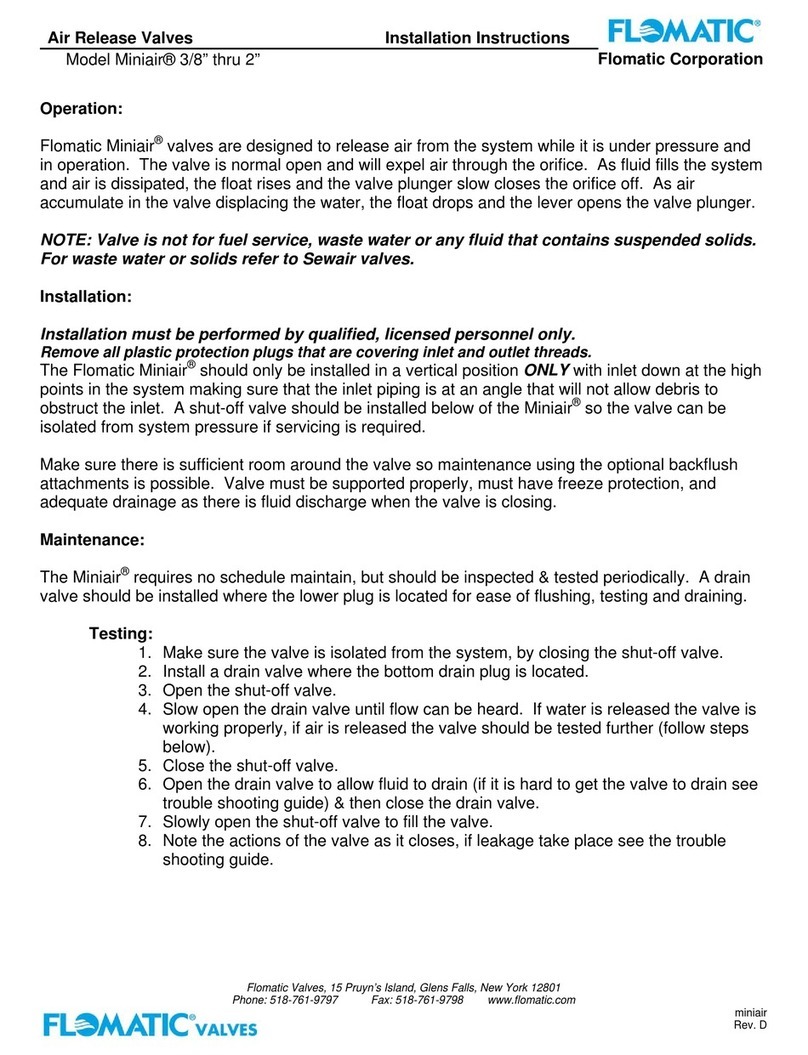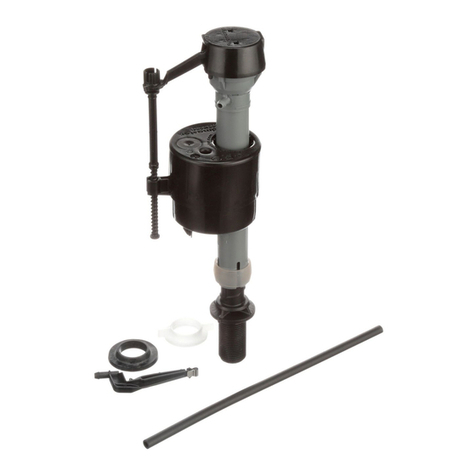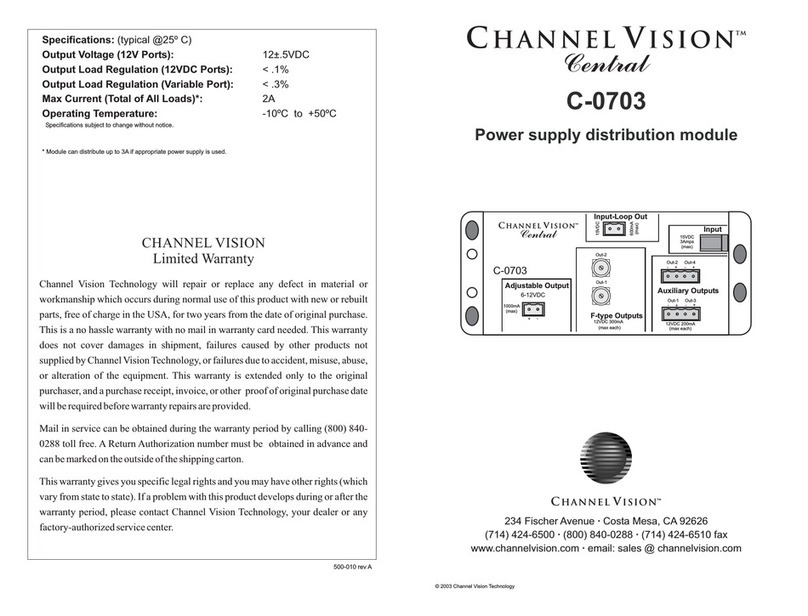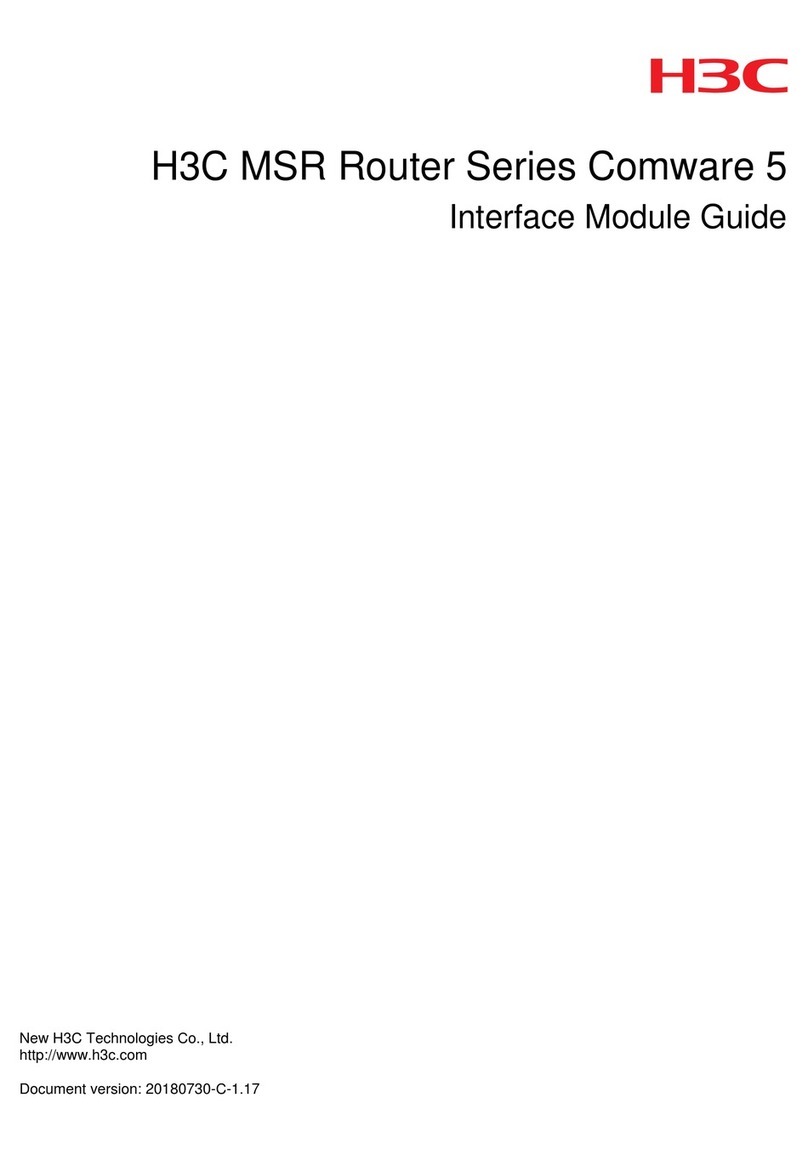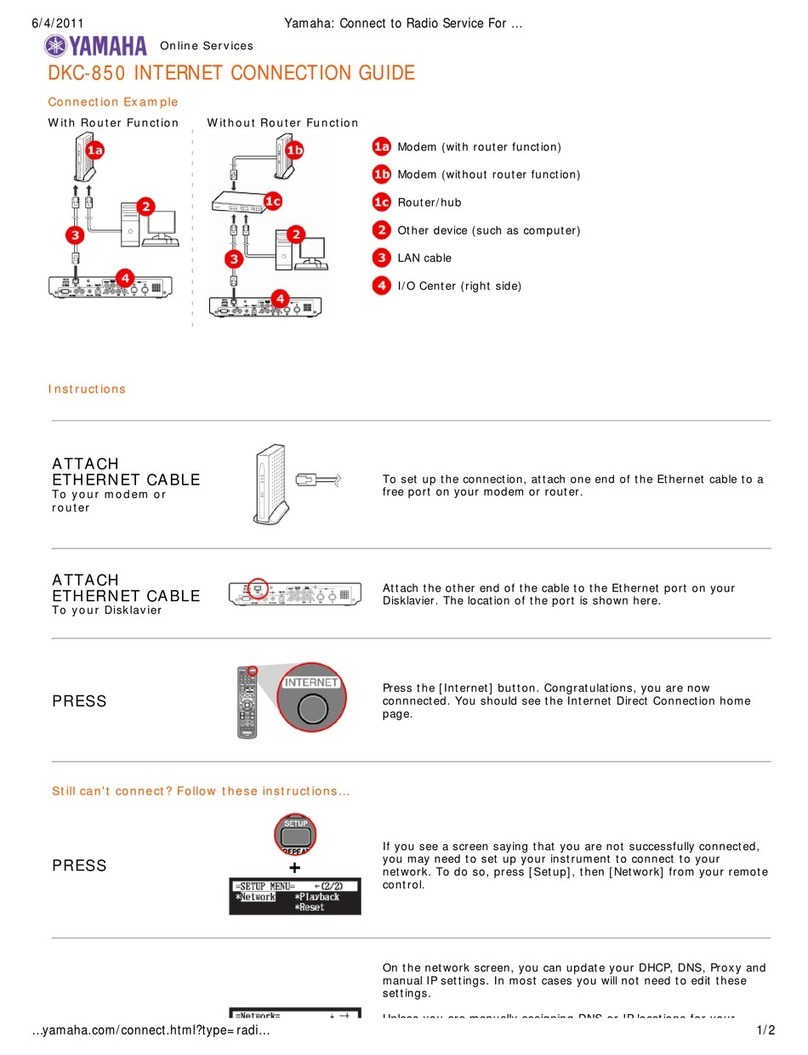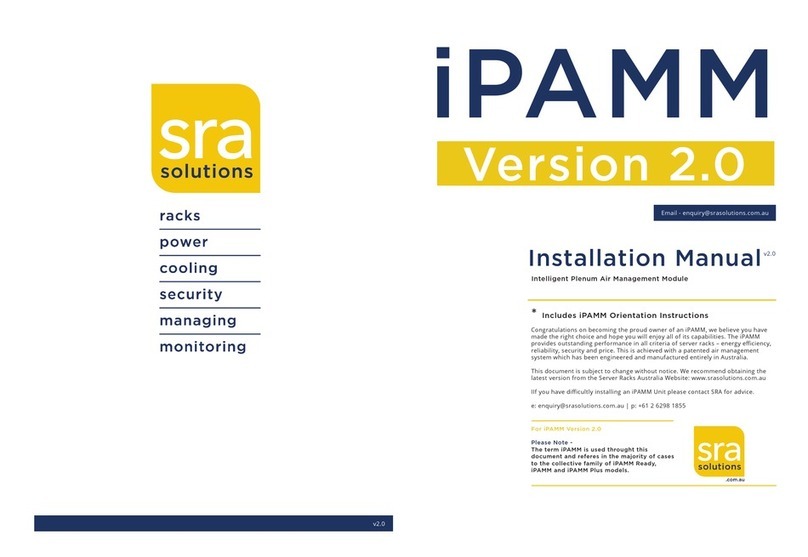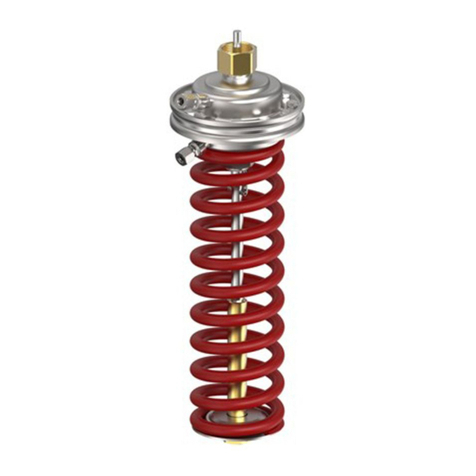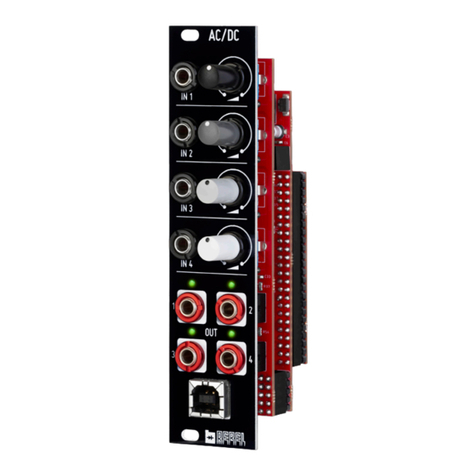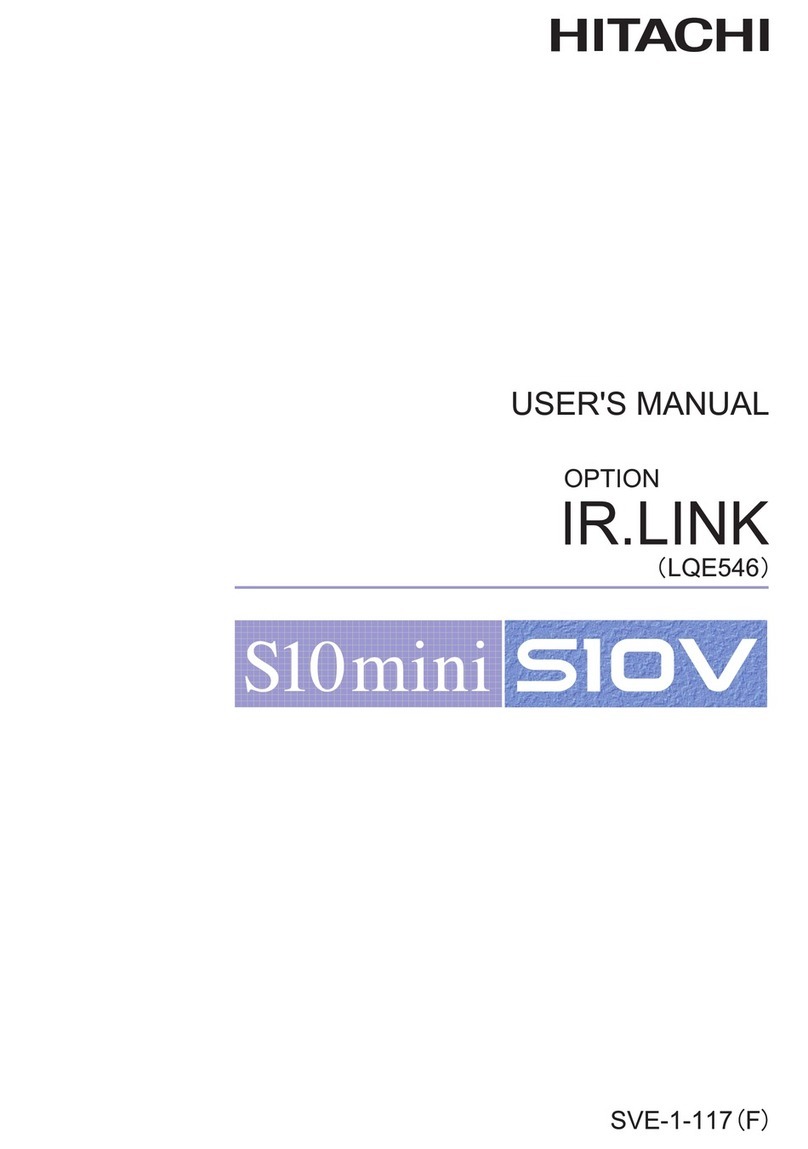KOOMANDO TM 5030 User manual

Centralina di comandoTM 5030
per tapparelle e tende da sole
Manuale Utente Pannello di Controllo
I. SPECIFICHE TECNICHE
1 Alimentazione: 220V AC50Hz
2 Temperatura di lavoro: -20º +60
3 Codica: Rolling code
4 Consumo in stand-by: 2W
5 Capacità motore: 0.5HP(360W), 230V
6 Fusibile integrato 10A
7 Frequenza di lavoro: 433.92MHz
8 Telecomandi memorizzabili max: 30
9 Dimensione: 93x57.5x26 mm
10 Peso: 124g
II. ISTRUZIONI PER LA SICUREZZA
- Si prega di leggere attentamente il presente manuale prima della
messa in funzione.
- Assicurarsi che il dispositivo non sia sotto tensione prima di aprire
il coperchio dell’apparecchiatura.
- Cancellare la memoria prima della messa in funzione della cen-
tralina (rif. IV. Cancellazione di tutta la memoria).
-
Il segnale può essere disturbato da altri dispositivi di comunicazione.
- La centralina deve essere utilizzata solo per il comando manuale
e/o via radio di motoriduttori per tapparelle e tende da sole.
E vietato l’uso per il controllo di sistemi ad alto rischio.
- Ogni rischio per la sicurezza va eliminato prima del suo utilizzo
.
- Installare in luogo asciutto al coperto o in apposito contenitore.
III. CONNESSIONI
L - N
ingresso linea 220V
COM ▲ UP e ▼ DOWN
uscite motore
messa a terra
Attenzione: il collegamento tra motore e centralina elettronica deve essere diretto, pulsanti o interruttori di comando preesistenti
devono essere eliminati.
A. Veriche di funzionamento
Se possibile posizionare la tapparella o la tenda a metà corsa. Accertarsi che l’alimentazione sia spenta prima di collegare il
dispositivo.
Dopo aver rimosso la copertura della centralina, collegare l’alimentazione AC220V, si accende il LED verde.
Premere il tasto ▲ (freccia in su) e vericare che la tapparella/tenda si apra.
Se invece di aprirsi si chiude, premere il tasto ▀ (STOP), scollegare l’alimentazione ed invertire i cavi dei morsetti ▲ UP e ▼
DOWN.
I tasti 1 / 2 / 3 del trasmettitore corrispondono rispettivamente a ▲ ▀ ▼ sulla centralina.
B. Cancellazione di tutta la memoria
Premere con una punta il tasto S1 (si accende il LED rosso) e tenerlo premuto per circa 8 sec no a quando il LED ritorna verde.
Rilasciare il tasto S1: il Led rosso lampeggia una volta poi torna verde. Ora la memoria è stata cancellata.
IT
DIP1: OFF controllo 3 tasti su teleco-
mando
(1 apre 2 stop 3 chiude)
ON controllo tasto singolo.
Se si comandano più centraline con lo
stesso radiocomando posizionare in ON.
DIP2: ON comando uomo presente
(al rilascio del tasto il motore si ferma)
OFF funzione semiautomatica.
DIP SWITCH
L M
COM
LED Indicatore di tensione
e memorizzazione
Pulsante di
apprendimento S1
Pulsanti di controllo
ON
1 2
www.koomando.com - il negozio dei telecomandi

C. Apprendimento telecomandi
1. Con una punta premere e rilasciare il tasto S1: si accende il LED rosso.
2. Premere due volte un tasto del telecomando: il LED sulla centralina lampeggia numerose volte. La memorizzazione è avvenuta con successo.
Se nessun segnale viene trasmesso entro 8 sec la centralina esce dalla fase di apprendimento.
3. Se il LED lampeggia una sola volta e torna rosso, la memorizzazione è fallita. Ripetere le operazioni dal punto 1.
4. Per memorizzare successivi telecomandi (no ad un massimo di 30) ripetere l’operazione dal punto1.
Ripetere le stesse operazioni per tutti i telecomandi da programmare.
D. Utilizzo del telecomando multiplo T7610 e T7710
Sul telecomando a 6 via T7610 usare i tasti laterali per scegliere quale centralina comandare: si accendono i numeri da 1 a 6. Utilizzate i tasti supe-
riore ed inferiore per comandare salita e discesa, il tasto centrale per lo stop.
Il telecomando T7710 può comandare no a 24 centraline suddivise in gruppi da 6, usare i tasti inferiori rosso e blu per cambiare gruppo (A, B, C,
D) usare i tasti laterali per scegliere la centralina da 1 a 6.
In entrambi i telecomandi, se si vogliono comandare la salita e la discesa di più motori contemporaneamente procedere in questo modo: il telecomando
dovrà essere memorizzato due volte sulle centraline TM5030 da abbinare (vedi apprendimento telecomandi), una prima volta selezionando sul teleco-
mando il numero da assegnare a quella centralina, una seconda volta dopo aver selezionato tramite le frecce laterali il comando generale (tutti i numeri
da 1 a 6 accesi). Dopo aver fatto i due apprendimenti tutte le centraline associate risponderanno sia al comando singolo che al comando generale.
E. Memorizzazione a distanza per i nuovi telecomandi
Memorizzazione di nuovi telecomandi senza intervenire sulla centralina elettronica.
Per aggiungere nuovi telecomandi consigliamo di eseguire sempre la procedura indicata al punto C.
Nel caso in cui la TM5030 non sia facilmente accessibile, si può memorizzare un nuovo telecomando utilizzando un altro telecomando già memorizza-
to:
1) Posizionarsi vicino alla centralina.
2) Premere contemporaneamente i tasti 1 e 2 del telecomando già memorizzato, rilasciare i tasti e premere immediatamente il tasto 2.
3) Sul nuovo telecomando premere il tasto scelto, rilasciare e poi premere nuovamente lo stesso tasto per almeno 1 secondo.
IV. FISSAGGIO
Perforazione
Per il montaggio praticare con il trapano due fori Ø6 profondi
35 mm, distanti 13 mm.
Installazione supporto
Fissare con i tasselli il supporto alla parete.
Fare attenzione alla direzione del supporto:
la parte più sporgente va posizionata verso l’alto (come da
gura).
Installazione centralina
Agganciare la centralina al supporto per ssare
alla parete.
Distribuito da KOOMANDO Srl - via Giovanni Paolo II, 45/C - Azzano Mella (BS) - 030 974 54 00 - [email protected]
Puoi visualizzare o scaricare le istruzioni in Italiano di questo prodotto all’indirizzo:
https://www.itelecomandi.com/istruzioni-centraline/
o con la scansione di questo QRcode:
IT
You can view or download english instructions for this product at:
https://www.itelecomandi.com/istruzioni-centraline/
or by scanning this QRcode:
EN
Vous pouvez afcher ou télécharger les instructions en français concernant ce produit à l’adresse suivante :
https://www.itelecomandi.com/istruzioni-centraline/
ou en scannant ce QRcode:
FR
Puedes visualizar o descargar las instrucciones en español de este producto en la dirección:
https://www.itelecomandi.com/istruzioni-centraline/
o con el barrido de este QRcode:
ES
Eine Anleitung in deutscher Sprache zu diesem Produkt können Sie unter der folgenden Adresse:
https://www.itelecomandi.com/istruzioni-centraline/
oder durch Scannen dieses QR-Codes einsehen oder herunterladen:
DE
TELECOMANDI AGGIUNTIVI ED ACCESSORI
Puoi acquistare altri telecomandi o accessori sul sito www.itelecomandi.com/accessori.html

TM 5030 Control unit
for blinds and awnings
User Manual - Control Panel
I. TECHNICAL SPECIFICATIONS
1 Power supply: 220V AC50Hz
2 Working temperature: -20° +60°
3 Encoding: Rolling code
4 Consumption in stand-by: 2W
5 Motor capacity: 0.5HP (360W), 230V
6 Integrated 10A fuse
7 Operating frequency: 433.92 MHz
8 Memorizable remote controls max: 30
9 Size: 93x57.5x26 mm
10 Weight: 124g
II. SAFETY INSTRUCTIONS
- Please read this manual carefully before operation.
- Ensure that the device is not powered up before opening the
appliance cover.
- Delete the memory before starting the control unit (ref. IV.
Deletion of all the memory).
- The signal can be disturbed by other communication devices.
- The control unit must only be used for the manual control and/or
radio control of gear motors for roller shutters and awnings.
Use for the control of high-risk systems is prohibited.
- All safety risks must be eliminated before use.
- Install in a dry place indoors or in a specic container
III. CONNECTIONS
Caution: The connection between the motor and the electronic control unit must be direct, pre-existing buttons or control
switches must be eliminated.
DIP1:
OFF control 3 keys on the remote
control (1 opens 2 stops 3 closes)
ON control single key.
If you control multiple control units with the
same radio control, set it to ON.
DIP2: ON manually controlled
(when the key is released, the motor stops)
OFF semi-automatic function.
DIP SWITCH
L N
COM
LED LED
Voltage indicator
and memorization
Button
learning S1
Control buttons
Control Panel
ON
1 2
SBS DM
A. Functionality checks
If possible, position the shutter or the awning halfway down.
Make sure the power is off before connecting the device.
After removing the cover of the control unit, connect the AC220V power supply, the green LED lights up.
Press the ▲ key (up arrow) and check that the shutter/awning opens.
If instead of opening it closes, press the ▀ (STOP) key, disconnect the power supply and invert the terminal cables
▲ UP and ▼ DOWN. The 1/2/3 keys on the transmitter correspond to ▲ ▀ ▼ on the control unit respectively.
B. Deletion of all the memory
Press the S1 key with a pointed object (the red LED lights up) and hold it down for about 8 seconds until the LED returns green.
Release the S1 key: the red LED ashes once and then returns green.
Now the memory has been deleted.
L - N
220V line input
COM ▲ UP e ▼ DOWN
motor outputs
GND
EN www.koomando.com - remote control store

C. Acquisition of the remote controls
1. Press and release the S1 key with a pointed object: the red LED lights up.
2. Press a key on the remote control twice: the LED on the control unit ashes several times. The memorization was successful.
If no signal is transmitted within 8 seconds, the control unit exits the acquisition phase.
3. If the LED ashes once and returns red, the memorization has failed, try again.
4. To memorize subsequent remote controls (up to a maximum of 30) repeat the operation from point 1.
Repeat the same operations for all the remote controls you need.
D. Using the T7610 and T7710 multiple remote control
On the T7610 6-way remote control, use the side keys to select which control unit to operate: the numbers from 1 to 6 light up. Use the upper
and lower keys to control the ascent and descent, the central key for the stop.
The T7710 remote control can command up to 24 control units divided into groups of 6, use the lower red and blue keys to change group (A,
B, C, D) use the side keys to select the control unit from 1 to 6.
In both remote controls, if you want to control the ascent and descent of several motors at the same time, proceed in this way: the remote
control must be memorised twice on the TM5030 control units to be matched (refer to the remote control acquisition), a rst time by selecting
the number to be assigned to that control unit on the remote control, a second time after selecting the general control with the side arrows
(all numbers 1 to 6 lit). After completing the two acquisitions, all the associated control units will respond to both the single control and to
the general control.
E. Remote memorization for new remote controls
Memorization of new remote controls without intervening on the electronic control unit.
To add new remote controls, we recommend always following the procedure indicated in point C.
If the TM5030 is not easily accessible, a new remote control can be memorized using another remote control already stored:
1) Position yourself near the control unit.
2) Simultaneously press keys 1 and 2 of the remote control already memorized, release the keys and immediately press key 2.
3) On the new remote control press the selected key, release and then press the same key again for at least 1 second.
IV. MOUNTING
Drilling
To mount drill two Ø6 holes 35 mm deep, 13 mm apart.
Mounting the support
Fix the support to the wall with the dowels.
Pay attention to the direction of the support:
The most protruding part must be positioned upward
(as shown in the gure).
Control unit installation
Attach the control unit to the support to be
attached to the wall.
Distributed by KOOMANDO Srl - via Giovanni Paolo II, 45/C - Azzano Mella (BS) - 030 974 54 00 - [email protected]
ADDITIONAL REMOTE CONTROLS AND ACCESSORIES
You can buy other remote controls or accessories on the website www.itelecomandi.com/accessori.html
Puoi visualizzare o scaricare le istruzioni in Italiano di questo prodotto all’indirizzo:
https://www.itelecomandi.com/istruzioni-centraline/
o con la scansione di questo QRcode:
IT
You can view or download english instructions for this product at:
https://www.itelecomandi.com/istruzioni-centraline/
or by scanning this QRcode:
EN
Vous pouvez afcher ou télécharger les instructions en français concernant ce produit à l’adresse suivante :
https://www.itelecomandi.com/istruzioni-centraline/
ou en scannant ce QRcode:
FR
Puedes visualizar o descargar las instrucciones en español de este producto en la dirección:
https://www.itelecomandi.com/istruzioni-centraline/
o con el barrido de este QRcode:
ES
Eine Anleitung in deutscher Sprache zu diesem Produkt können Sie unter der folgenden Adresse:
https://www.itelecomandi.com/istruzioni-centraline/
oder durch Scannen dieses QR-Codes einsehen oder herunterladen:
DE

Centrale de commande TM 5030
pour volets roulants et rideaux solaires
Manuel Utilisateur - Panneau de Contrôle
I. SPÉCIFICATIONS TECHNIQUES
1 Alimentation: 220V AC50Hz
2 Température de travail: -20º +60
3 Codication: Rolling code
4 Consommation en stand-by: 2W
5 Capacité moteur: 0.5HP(360W), 230V
6 Fusible intégré 10A
7 Fréquence de travail: 433.92MHz
8 Télécommandes mémorisables max: 30
9 Dimension: 93x57.5x26 mm
10 Poids: 124g
II. INSTRUCTIONS CONCERNANT LA SÉCURITÉ
- Prière de lire attentivement ce manuel avant la mise en fonction.
- Avant d’ouvrir le couvercle de l’appareillage, assurez-vous que le
dispositif n’est pas sous tension.
- Effacer la mémoire avant de mettre en fonction la centrale (réf. IV.
Effacement de toute la mémoire).
-
Le signal peut être dérangé par d’autres dispositifs de communication.
-
La centrale ne doit être utilisée que pour la commande manuelle et/ou
via radio de motoréducteurs pour volets roulants et rideaux solaires.
L’emploi pour le contrôle de systèmes à haut risque est interdit.
- Tout risque relatif à la sécurité doit être éliminé avant l’utilisation.
- Installer dans un lieu sec et à l’abri ou dans un conteneur prévu à
cet effet.
III. CONNEXIONS
Attention: la connexion entre le moteur et la centrale électronique doit être directe; toute touche ou interrupteur de commande
préexistant est à éliminer.
DIP SWITCH
L N
COM
LED LED
indicateur de tension
et mémorisation
Bouton
d’apprentissage S1
Boutons de contrôle
Panneau de Contrôle
ON
1 2
SBS DM
DIP1: OFF contrôle 3 touches sur télécom-mande
(1 ouvre 2 stop 3 ferme)
ON contrôle touche singulière.
Si plusieurs centrales sont commandées avec l
a même radiocommande, positionner sur ON.
DIP2: ON commande homme présent
(à la relâche de la touche, le moteur s’arrête)
OFF fonction semi-automatique
A. Contrôles de fonctionnement
Si possible, positionner le volet roulant ou le rideau à mi-course.
S’assurer que l’alimentation est éteinte avant de connecter le dispositif.
Après avoir retiré le couvercle de la centrale, connecter l’alimentation AC220V, le LED vert s’allume.
Appuyer sur la touche ▲ (èche en haut) et vérier que le volet roulant/rideau s’ouvre.
Si au lieu de s’ouvrir, il se ferme, appuyer sur la touche ▀ (STOP), débrancher l’alimentation, et inverser les câbles des bornes ▲
UP et ▼ DOWN. Les touches 1 / 2 / 3 de l’émetteur correspondent respectivement à ▲ ▀ ▼ sur la centrale.
B. Effacement de toute la mémoire
À l’aide d’une pointe, appuyer sur la touche S1 (le LED rouge s’illumine) et la maintenir pressée encore pendant 8 sec, le temps
que le LED redevienne vert.
Relâcher la touche S1: le Led rouge clignote une fois puis redevient vert.
La mémoire est désormais effacée.
L - N
entrée de ligne d’ali-
mentation 220V
COM ▲ UP e ▼ DOWN
sorties moteur
mise à la terre
FR www.koomando.com - la maison des télécommandes

C. Apprentissage télécommandes
1. À l’aide d’une pointe, appuyer sur la touche S1 puis relâcher: le LED rouge s’illumine.
2. Appuyer deux fois sur une touche de la télécommande: le LED sur la centrale clignote de nombreuses fois. La mémorisation a
eu lieu avec succès. Si aucun signal n’est transmis dans les 8 sec., la centrale sort de la phase d’apprentissage.
3. Si le LED ne clignote qu’une seule fois et redevient rouge, cela signie que la mémorisation a échouée. Répéter les opérations à
partir du point 1.
4. Pour mémoriser d’autres télécommandes (jusqu’à un max. de 30), répéter l’opération à partir du point 1.
Répétez les mêmes opérations pour toutes les télécommandes à programmer.
D. Emploi de la télécommande multiple T7610 et T7710
Sur la télécommande à 6 voies T7610, utiliser les touches latérales an de choisir la centrale à commander: les numéros de 1 à 6 s’allument.
Utilisez les touches supérieure et inférieure pour commander la montée et la descente, la touche centrale pour le stop.
La télécommande T7710 peut commander jusqu’à 24 centrales divisées en groupes de 6; utiliser les touches inférieures rouge et bleue pour
changer de groupe (A, B, C, D); utiliser les touches latérales pour choisir la centrale de 1 à 6.
Pour commander simultanément la montée et la descente de plusieurs moteurs sur les deux télécommandes, procéder ainsi: la télécom-
mande devra être mémorisée deux fois sur les centrales TM5030 à associer (voir apprentissage télécommandes), une première fois en
sélectionnant le numéro à assigner à celle de la centrale, une deuxième fois après avoir sélectionné la commande générale à l’aide des
èches latérales (tous les numéros de 1 à 6 allumés). Après avoir effectué les deux apprentissages, toutes les centrales associées répon-
dront aussi bien à la commande singulière qu’à la commande générale.
E. Mémorisation à distance pour les nouvelles télécommandes
Mémorisation de nouvelles télécommandes sans intervenir sur l’unité de contrôle électronique.
Pour ajouter de nouvelles télécommandes, nous vous recommandons de toujours suivre la procédure indiquée au point C.
Si le TM5030 n’est pas facilement accessible, vous pouvez mémoriser une nouvelle télécommande à l’aide d’une autre télécommande
déjà enregistrée:
1) positionnez-vous près de l’unité de contrôle
2) Appuyez simultanément sur les touches 1 et 2 de la télécommande déjà mémorisées, relâchez les touches et appuyez immédiatement
sur la touche 2
3) Sur la nouvelle télécommande, appuyez sur la touche sélectionnée, relâchez-la puis appuyez à nouveau sur la même touche pendant
au moins 1 seconde.
IV. FIXATION
Perforation
Pour le montage, pratiquer deux orices de Ø6 profon-
ds 35 mm, distants 13 mm.
Installation support
Fixer le support au mur à l’aide des chevilles.
Veiller à la direction du support:
la partie la plus saillante doit être positionnée
vers le haut (comme en gure).
Installation centrale
Accrocher la centrale au support de xation au mur.
Distribué par KOOMANDO Srl - via Giovanni Paolo II, 45/C - Azzano Mella (BS) - 030 974 54 00 - [email protected]
TÉLÉCOMMANDES ET ACCESSOIRES SUPPLÉMENTAIRES
Vous pouvez acheter d’autres télécommandes ou accessoires sur le site web www.itelecomandi.com/accessori.html
Puoi visualizzare o scaricare le istruzioni in Italiano di questo prodotto all’indirizzo:
https://www.itelecomandi.com/istruzioni-centraline/
o con la scansione di questo QRcode:
IT
You can view or download english instructions for this product at:
https://www.itelecomandi.com/istruzioni-centraline/
or by scanning this QRcode:
EN
Vous pouvez afcher ou télécharger les instructions en français concernant ce produit à l’adresse suivante :
https://www.itelecomandi.com/istruzioni-centraline/
ou en scannant ce QRcode:
FR
Puedes visualizar o descargar las instrucciones en español de este producto en la dirección:
https://www.itelecomandi.com/istruzioni-centraline/
o con el barrido de este QRcode:
ES
Eine Anleitung in deutscher Sprache zu diesem Produkt können Sie unter der folgenden Adresse:
https://www.itelecomandi.com/istruzioni-centraline/
oder durch Scannen dieses QR-Codes einsehen oder herunterladen:
DE

Centralita de mando TM 5030
para persianas y toldos
Manual del Usuario - Panel de Control
I. ESPECIFICACIONES TÉCNICAS
1 Alimentación: 220V AC 50Hz
2
Temperatura de funcionamiento: de -20 a +60°C
3 Codicación: Rolling code
4 Consumo en stand-by: 2W
5 Capacidad del motor: 0.5HP (360W) 230V
6 Fusible integrado: 10A
7 Frecuencia de transmisión: 433.92MHz
8 Mandos a distancia memorizables máx: 30
9 Dimensión: 93x57 5x26 mm
10 Peso: 124g
II. NORMAS DE SEGURIDAD
-
Se ruega leer atentamente el presente manual antes de la puesta en
funcionamiento.
- Asegúrese que el dispositivo esté desconectado de la alimentación
eléctrica antes de abrir la tapa del aparato.
- Borre la memoria antes de la puesta en marcha de la centralita (ref. IV.
Cancelación de toda la memoria).
- La señal puede verse afectada por interferencias causadas por otros
dispositivos de comunicación.
- La centralita debe ser usada solamente para la puesta en marcha
manual y/o vía radio de motorreductores para persianas y toldos.
Queda prohibido su uso para el control de sistemas de alto riesgo.
- Todo riesgo para la seguridad debe ser eliminado antes de su uso.
- Instale en un lugar seco y cubierto o en el correspondiente recipiente.
III. CONEXIONES
Atención: la conexión entre el motor y la centralita electrónica debe ser directa; pulsadores o interruptores de
mando preexistentes deben ser eliminados.
DIP1: OFF control de 3 botones del mando a
distancia (1 abre 2 stop 3 cierra)
ON control con un solo botón.
Si se accionan más centralitas con el mismo
radiomando coloque en posición de encen-
dido ON.
DIP2: ON puesta en marcha por presencia
de personas (cuando se suelta el botón el
motor se para)OFF función semiautomáti
ca.
DIP SWITCH
L N
COM
LED LED
indicador de voltaje
y memorización
Botón
aprendizaje S1
Botones de control
Panel de Control
ON
1 2
SBS DM
A. Comprobación de funcionamiento
Si es posible coloque la persiana o el toldo en mitad de carrera.
Asegúrese que la alimentación eléctrica esté apagada antes de conectar el dispositivo.
Después de haber extraído la cubierta de la centralita, conecte la alimentación AC220V y se encenderá el LED verde.
Pulse el botón ▲ (echa hacia arriba) y compruebe que la persiana/toldo se abre.
Si en lugar de abrirse se cierra, pulse el botón ▀ (STOP), desconecte la alimentación eléctrica e invierta los cables de los bornes
de conexión▲ UP y ▼ DOWN.
Los botones 1 / 2 / 3 del emisor corresponden respectivamente a ▲ ▀ ▼ de la centralita.
B. Cancelación de toda la memoria
Pulse con una punta el botón S1(se enciende el LED rojo) y téngalo pulsado aproximadamente unos 8 s hasta que el LED vuelva
a ser verde. Suelte el botón S1: el Led rojo parpadea una vez y luego vuelve a ser verde.
Ahora la memoria ha sido borrada.
L - N
Entrada de línea de
220V
COM ▲ UP e ▼ DOWN
salidas de motor
GND
ES www.koomando.com - la tienda de mandos

C. Aprendizaje de los mandos a distancia
1. Con una punta pulse y suelte el botón S1: se enciende el LED rojo.
2. Pulse dos veces un botón del mando a distancia: el LED de la centralina parpadea numerosas veces. La memorización se ha
llevado a cabo con éxito. En caso de que no se transmita ninguna señal en 8 s la centralita sale de la fase de aprendizaje.
3. Si el LED parpadea solamente una vez y se vueve rojo, la memorización ha fallado, inténtelo de nuevo.
4. Para memorizar sucesivos mandos a distancia (hasta un máximo de 30) repita la operación desde el punto 1.
Repetir las mismas operaciones para todos los mandos a distancia a programar.
D. Utilización del mando a distancia múltiple T7610 y T7710
En el mando a distancia con 6 canales T7610 use los botones laterales para elegir la centralita que se quiere poner en marcha: se encen-
derán los números del 1 al 6. Use los botones superiores e inferiores para accionar la subida y la bajada y la tecla central para el stop.
El mando a distancia T7710 puede poner en marcha hasta 24 centralitas subdivididas en grupos de 6; use los botones inferiores de color
rojo y azul para cambiar el grupo (A, B, C, D) y use los botones laterales para elegir la centralita del 1 al 6.
En ambos mandos a distancia, si se quiere accionar contemporáneamente la subida o la bajada de más motores, proceda de la siguiente
manera: el mando a distancia deberá ser memorizado dos veces en las centralitas TM5030 que deben combinarse (veáse aprendizaje de
los mandos a distancia), una vez seleccionando en el mando a distancia el número que queremos asignar a la correspondiente centralita y
una segunda vez después de haber seleccionado con las echas laterales la puesta en marcha general (todos los números del 1 al 6 en-
cendidos). Después de haber llevado a cabo los dos aprendizajes todas las centralitas asociadas responderán tanto a la puesta en marcha
individual como general.
E. Memorización remota para nuevos mandos a distancia
Memorización de nuevos mandos a distancia sin intervenir en la unidad de control electrónico.
Para agregar nuevos controles remotos, recomendamos seguir siempre el procedimiento indicado en el punto C.
Si no se puede acceder fácilmente al TM5030, se puede memorizar un nuevo control remoto usando otro control remoto ya almacenado:
1) Colóquese cerca de la unidad de control.
2) Presione simultáneamente las teclas 1 y 2 del control remoto ya memorizado, suelte las teclas y presione inmediatamente la tecla 2.
3) En el nuevo control remoto, presione la tecla seleccionada, suelte y luego presione la misma tecla nuevamente durante al menos 1
segundo.
IV. FIJACIÓN
Perforación
Para el montaje efectúe con el taladro dos oricios de
Ø6 con una profundidad de 35 mm y que sean distantes
13 mm.
Instalación del soporte
Fije con los pernos el soporte a la pared.
Preste atención a la dirección del soporte:
la parte más pronunciada debe posicionarse hacia
arriba (tal y como se indica en la gura).
Instalación de la centralita
Enganche la centralita al soporte para jarla en la
pared.
Distribuido por KOOMANDO Srl - via Giovanni Paolo II, 45/C - Azzano Mella (BS) - 030 974 54 00 - [email protected]
CONTROLES Y ACCESORIOS REMOTOS ADICIONALES
Puedes comprar otros mandos a distancia o accesorios en la web www.koomando.com/accessori.html
Puoi visualizzare o scaricare le istruzioni in Italiano di questo prodotto all’indirizzo:
https://www.itelecomandi.com/istruzioni-centraline/
o con la scansione di questo QRcode:
IT
You can view or download english instructions for this product at:
https://www.itelecomandi.com/istruzioni-centraline/
or by scanning this QRcode:
EN
Vous pouvez afcher ou télécharger les instructions en français concernant ce produit à l’adresse suivante :
https://www.itelecomandi.com/istruzioni-centraline/
ou en scannant ce QRcode:
FR
Puedes visualizar o descargar las instrucciones en español de este producto en la dirección:
https://www.itelecomandi.com/istruzioni-centraline/
o con el barrido de este QRcode:
ES
Eine Anleitung in deutscher Sprache zu diesem Produkt können Sie unter der folgenden Adresse:
https://www.itelecomandi.com/istruzioni-centraline/
oder durch Scannen dieses QR-Codes einsehen oder herunterladen:
DE

Steuergerät TM 5030
für Rollläden und Markisen
Benutzerhandbuch Steuertafel
I. TECHNISCHE DATEN
1 Versorgung: 220V AC50Hz
2 Betriebstemperatur: -20º +60
3 Kodizierung: Rolling code
4 Verbrauch im Standby: 2W
5 Motorleistung: 0.5HP(360W), 230V
6 Integrierte Sicherung 10A
7 Arbeitsfrequenz: 433.92MHz
8 Max speicherbare Fernsteuerungen: 30
9 Abmessung: 93x57.5x26 mm
10 Gewicht: 124g
II. SICHERHEITSHINWEISE
-
Bitte lesen Sie diese Anleitung vor der Inbetriebnahme sorgfältig durch.
- Stellen Sie vor dem Öffnen der Geräteabdeckung sicher, dass das
Gerät nicht eingeschaltet ist.
- Löschen Sie den Speicher, bevor Sie das Steuergerät starten (Ref. IV.
Löschen des gesamten Speichers).
- Das Signal kann von anderen Kommunikationsgeräten gestört werden.
- Das Steuergerät darf nur zur manuellen und/oder Funksteuerung von
Getriebemotoren für Rollläden und Markisen verwendet werden.
Die Verwendung zur Steuerung von Hochrisikosystemen ist verboten.
- Alle Sicherheitsrisiken müssen vor Gebrauch beseitigt werden.
- An einem trockenen Ort im Inneren oder in einem speziellen Behälter
aufstellen.
III. ANSCHLÜSSE
Achtung: Der Anschluss zwischen Motor und elektronischem Steuergerät muss direkt sein, bereits bestehende Tasten oder
Schalter zur Steuerung müssen entfernt werden.
DIP1: OFF steuert 3 Tasten auf der
Fernsteuerung (1 Öffnen 2 Stopp 3
Schließen).ON steuert eine einzelne Taste.
Wenn Sie mehrere Steuergeräte mit dersel-
ben Funksteuerung steuern, auf ON stellen.
DIP2: ON steuert den nicht automatischen
Betrieb (bei Lösen der Taste stoppt der
Motor). OFF funktioniert halbautomatisch.
DIP SWITCH
L N
COM
LED LED
Spannungsanzeige
und Auswendiglernen
Lerntaste S1
Steuertasten
Steuertasten
ON
1 2
SBS DM
A. Überprüfung des Betriebs
SWenn möglich, den Rollladen oder die Markise auf der Hälfte positionieren.
Stellen Sie sicher, dass die Stromversorgung ausgeschaltet ist, bevor Sie das Gerät anschließen.
Nach dem Entfernen der Abdeckung des Steuergeräts schließen Sie das Netzteil AC220V an, die grüne LED leuchtet auf.
Drücken Sie die Taste ▲ (Pfeil nach oben) und stellen Sie sicher, dass der Rollladen/die Markise sich öffnet.
Wenn anstatt der Öffnung, das Schließen erfolgt, drücken Sie die Taste ▀ (STOPP), trennen Sie die Stromversorgung und kehren
Sie die Kabel der Klemmen um
▲ HOCH und ▼ RUNTER. Die Tasten 1 / 2 / 3 des Senders entsprechen jeweils ▲ ▀ ▼ am Steuergerät.
B. Löschen des gesamten Speichers
Drücken Sie die Taste S1 (die rote LED leuchtet) und halten Sie sie für etwa 8 Sekunden gedrückt, bis die LED grün leuchtet.
Lassen Sie die Taste S1 los: Die rote LED blinkt einmal und wird dann wieder grün.
Jetzt wurde der Speicher gelöscht.
L - N
220 V Leitungseingang
COM ▲ UP e ▼ DOWN
Motorleistungen
GND
DE www.koomando.com - die handsender shop

C. Einrichtung der Fernsteuerung
1. Mit einer Spitze die Taste S1 drücken und loslassen: Die rote LED leuchtet auf.
2. Drücken Sie eine Taste auf der Fernsteuerung zweimal: Die LED am Steuergerät blinkt mehrmals. Das Speichern ist erfolgreich
verlaufen. Wenn innerhalb von 8 Sekunden kein Signal gesendet wird, verlässt das Steuergerät die Einrichtungsphase.
3. Wenn die LED einmal blinkt und rot leuchtet, ist der Speichervorgang fehlgeschlagen, erneut versuchen.
4. Um spätere Fernsteuerungen zu speichern (bis maximal 30) den Vorgang ab Punkt 1 wiederholen.
Wiederholen Sie die gleichen Vorgänge für alle zu programmierenden Fernbedienungen.
D. Verwendung der Mehrfach-Fernsteuerung T7610 und T7710
Bei der 6-Wege-Fernsteuerung T7610 verwenden Sie die Seitentasten, um auszuwählen, welches Steuergerät gesteuert werden soll: die
Nummern 1 bis 6 leuchten auf. Verwenden Sie die oberen und unteren Tasten, um nach oben und unten zu steuern, die mittlere Taste für
den Stopp.
Die Fernsteuerung T7710 kann bis zu 24 Steuergeräte steuern, die in Gruppen von 6 unterteilt sind. Verwenden Sie die unteren roten und
blauen Tasten, um die Gruppe (A, B, C, D) zu ändern. Verwenden Sie die Seitentasten, um das Steuergerät von 1 bis 6 zu wählen.
In beiden Fernsteuerungen, wenn Sie den Auf- und Abstieg von mehreren Motoren gleichzeitig steuern möchten, gehen Sie wie folgt
vor: Die Fernsteuerung muss zweimal auf den zu kombinierenden Steuergeräten TM5030 gespeichert werden (siehe Einrichtung, ein
erstes Mal, indem Sie auf der Fernsteuerung die Nummer auswählen, die diesem Steuergerät zugewiesen werden soll, ein zw¬eites
Mal, nachdem Sie den allgemeinen Befehl (alle Nummern von 1 bis 6) durch die seitlichen Pfeile ausgewählt haben. Nachdem die zwei
Einrichtungsvorgänge durchgeführt wurden, reagieren alle zugehörigen Steuergeräte sowohl auf den einzelnen Befehl als auch auf den
allgemeinen Befehl.
E. Remote-Speicher für neue Fernsteuerungen
Speicherung neuer Fernbedienungen ohne Eingriff in die elektronische Steuereinheit.
Um neue Fernbedienungen hinzuzufügen, empfehlen wir, immer das in Punkt C angegebene Verfahren zu befolgen.
Wenn der TM5030 nicht leicht zugänglich ist, kann eine neue Fernbedienung mit einer anderen bereits gespeicherten Fernbedienung gespei-
chert werden:
1) Positionieren Sie sich in der Nähe der Steuereinheit.
2) Drücken Sie gleichzeitig die Tasten 1 und 2 der Fernbedienung, geben Sie die Tasten frei und drücken Sie sofort die Taste 2.
3) Drücken Sie auf der neuen Fernbedienung die ausgewählte Taste, lassen Sie sie wieder los und drücken Sie sie erneut für mindestens 1
Sekunde.
IV. BEFESTIGUNG
Bohrung
Für die Montage bohren Sie zwei 35 mm tiefe Löcher
Ø6, mit 13 mm Abstand voneinander.
Installation der Halterung
Befestigen Sie die Halterung mit den Dübeln an der
Wand.
Achten Sie auf die Ausrichtung der Halterung:
Der am meisten hervorstehende Teil muss nach oben
positioniert werden (wie in der Abbildung gezeigt).
Installation des Steuergeräts
Haken Sie das Steuergerät an der Halterung ein, um
sie an der Wand zu befestigen.
Ausgegeben durch
KOOMANDO Srl - via Giovanni Paolo II, 45/C - Azzano Mella (BS) - 030 974 54 00 - [email protected]
ZUSÄTZLICHE FERNBEDIENUNGEN UND ZUBEHÖR
Sie können andere Fernbedienungen oder Zubehör auf der Website kaufen www.koomando.com/accessori.html
Puoi visualizzare o scaricare le istruzioni in Italiano di questo prodotto all’indirizzo:
https://www.itelecomandi.com/istruzioni-centraline/
o con la scansione di questo QRcode:
IT
You can view or download english instructions for this product at:
https://www.itelecomandi.com/istruzioni-centraline/
or by scanning this QRcode:
EN
Vous pouvez afcher ou télécharger les instructions en français concernant ce produit à l’adresse suivante :
https://www.itelecomandi.com/istruzioni-centraline/
ou en scannant ce QRcode:
FR
Puedes visualizar o descargar las instrucciones en español de este producto en la dirección:
https://www.itelecomandi.com/istruzioni-centraline/
o con el barrido de este QRcode:
ES
Eine Anleitung in deutscher Sprache zu diesem Produkt können Sie unter der folgenden Adresse:
https://www.itelecomandi.com/istruzioni-centraline/
oder durch Scannen dieses QR-Codes einsehen oder herunterladen:
DE
Table of contents
Languages:
Popular Control Unit manuals by other brands
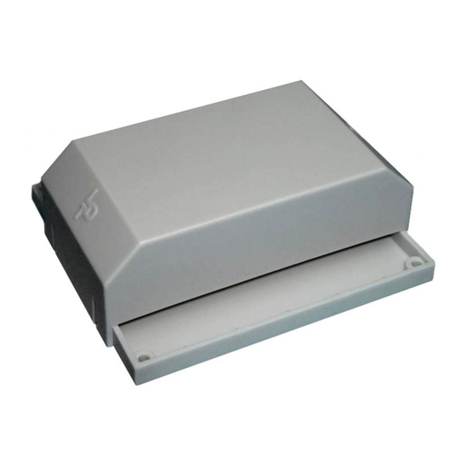
LDT
LDT s88-ClockMaster Series operating instructions

Tews Technologies
Tews Technologies TIP866-TM-20 user manual
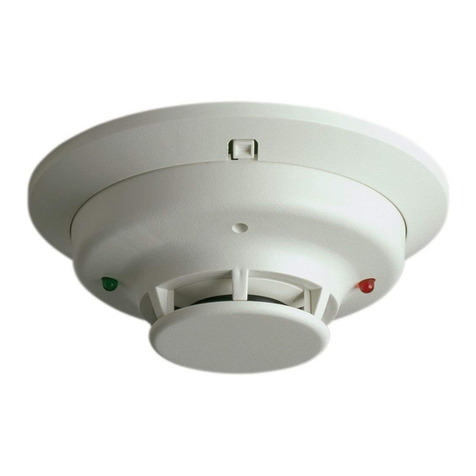
System Sensor
System Sensor i3 Series Installation and maintenance instructions
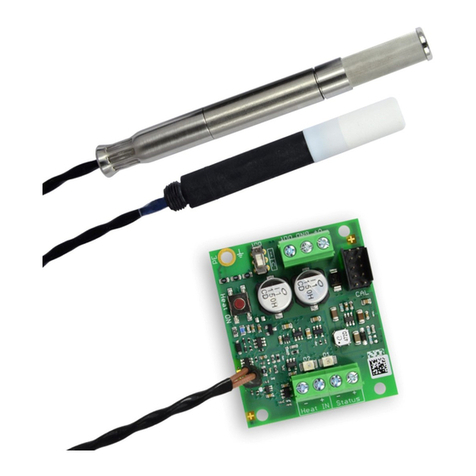
E+E Elektronik
E+E Elektronik EE1900 user manual
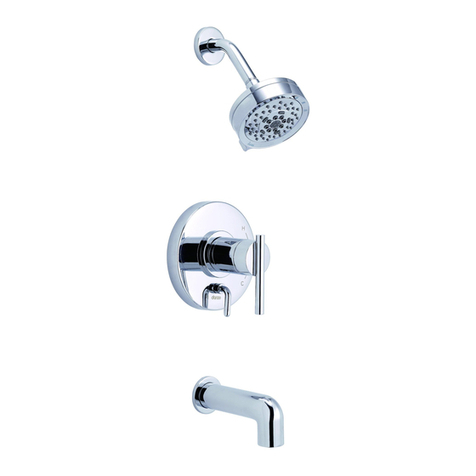
Danze
Danze Treysta D511058TC installation instructions
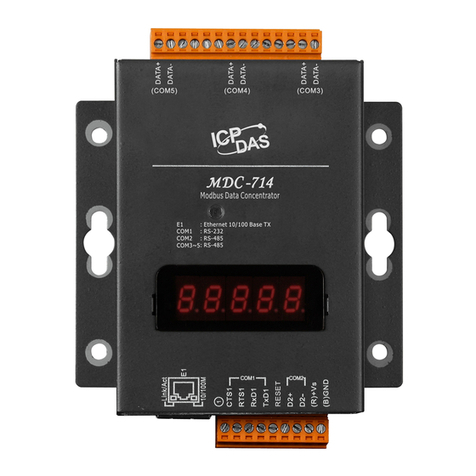
ICP DAS USA
ICP DAS USA MDC-700 Series user manual
